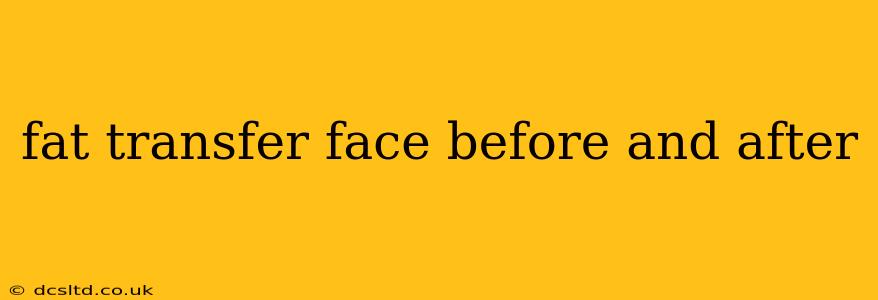Fat transfer to the face, also known as autologous fat grafting or facial fat grafting, is a cosmetic procedure that uses your own body fat to enhance facial features, reduce wrinkles, and rejuvenate your overall appearance. This minimally invasive procedure offers a natural-looking alternative to fillers and other injectables. But what can you expect before and after the procedure? Let's explore.
What Happens Before a Facial Fat Transfer?
Before your procedure, a comprehensive consultation with a qualified plastic surgeon or dermatologist is crucial. This consultation will cover several key aspects:
- Assessment of Your Needs: Your surgeon will evaluate your facial structure, skin quality, and desired outcomes. They'll discuss your goals and determine if fat grafting is the right approach for you.
- Medical History Review: A thorough review of your medical history, including any allergies, medications, and pre-existing conditions, is essential to ensure your safety.
- Pre-Operative Instructions: You'll receive detailed instructions on preparing for the procedure, such as dietary restrictions and medications to avoid. This may include avoiding certain blood thinners or supplements.
- Realistic Expectations: Your surgeon will manage expectations by discussing potential risks, recovery time, and the possibility of needing multiple procedures to achieve optimal results. It's important to have a realistic understanding of what the procedure can and cannot achieve.
What is the Facial Fat Transfer Procedure Like?
The procedure typically involves two steps:
- Liposuction: Fat is harvested from a donor site on your body (commonly the abdomen, thighs, or hips) using liposuction. This involves making small incisions and using a cannula to gently remove fat cells.
- Fat Grafting: The harvested fat is then processed to remove excess fluid and impurities. The purified fat is carefully injected into the areas of the face requiring enhancement. This process involves using very fine needles to distribute the fat evenly and precisely.
The procedure is performed under local anesthesia or sedation, depending on the extent of the procedure and your preferences.
What Can I Expect After a Facial Fat Transfer?
The recovery period varies, but you can anticipate:
- Swelling and Bruising: Swelling and bruising are common after the procedure and typically subside within a few weeks.
- Discomfort: You might experience some mild discomfort, which can be managed with pain medication.
- Gradual Results: The final results are not immediate. It takes time for the grafted fat to integrate into the treated areas, and some fat cells will be reabsorbed by the body. Multiple treatments might be necessary to achieve optimal, lasting results.
- Follow-up Appointments: Your surgeon will schedule follow-up appointments to monitor your progress and ensure proper healing.
How Long Do the Results Last?
The longevity of results varies depending on individual factors such as age, lifestyle, and overall health. A significant portion of the transferred fat is typically absorbed by the body, but a substantial amount usually remains, providing long-lasting results for many patients. Some studies suggest a significant portion of the fat remains permanent.
What are the Potential Risks and Complications?
As with any surgical procedure, there are potential risks and complications, including infection, hematoma (blood clot), asymmetry, and unsatisfactory results. These risks are minimized with proper patient selection, meticulous surgical technique, and post-operative care.
Does Fat Transfer to the Face Hurt?
The procedure itself is generally not painful because anesthesia is used. However, you may experience some discomfort or soreness afterward, which can be easily managed with pain medication.
Is Fat Transfer to the Face Permanent?
While some fat cells are naturally reabsorbed by the body, a substantial amount usually remains, providing long-lasting results. The permanence of results can vary depending on individual factors.
How Much Does a Fat Transfer Face Cost?
The cost of a facial fat transfer varies based on several factors including the surgeon's fee, anesthesia costs, and facility fees. It's best to consult with your chosen surgeon for an accurate cost estimate.
Conclusion:
Facial fat transfer offers a natural and effective approach to facial rejuvenation. However, it's essential to choose a qualified and experienced surgeon to achieve the best possible results. Thorough research, realistic expectations, and open communication with your surgeon are crucial for a successful outcome. Remember, this information is for educational purposes and should not be considered medical advice. Always consult with a qualified medical professional for personalized guidance.
